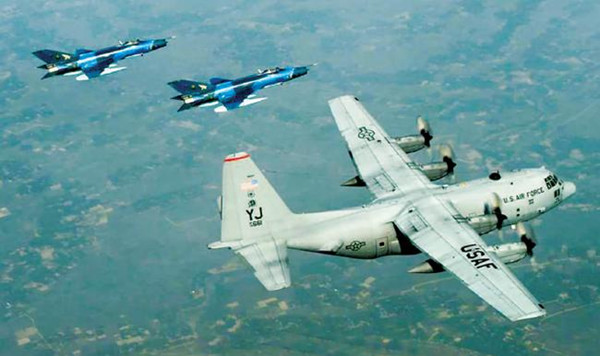

The picture shows that two J-7BG fighters of the Bangladesh Air Force are carrying out the accompanying flight with a C-130H transport aircraft of the U.S. Air Force in the Bangladesh-U.S. joint military exercise codenamed "Deal with the South" on January 28, 2015.
China-made J-7BG fighters from the 5th Tactical Fighter Squadron with the highest combat-readiness level of the Bangladesh Air Force carried out the accompanying flight with a visiting C-130H transport aircraft from the 374th Airlift Wing of the US Air Force in a Bangladesh-US joint military exercise codenamed "Deal with the South" on January 28, 2015.
"The J-7 fighters are gradually disappearing from the active-service fighters of the Chinese People's Liberation Army Air Force (PLAAF)," Malaysia's Asian Defense Journal reported. But the journal listed many other countries in the Asia-Pacific region which still use J-7 fighters as the main fighters of their air forces, showing that the classic China-made 2nd-generation fighters are still playing their roles in other countries, although they already began to "retire" from the PLAAF.
Since its first flight in 1965, the China-made J-7 fighter family had been constantly developing until it went out of production in 2006. China had produced a total of more that 4,000 J-7 fighters in over 40 years. In addition to being served in the PLAAF and the Chinese People's Liberation Navy (PLAN), some J-7 fighters were exported to more than 30 countries as the most famous fighter brand of China for export.
Due to its excellent performance, the J-7 fighter is hailed as the "F-16 fighter of small countries". Although the J-7 fighter is old, it still plays important roles of guarding the airspaces of many countries.
The earliest J-7 fighter
The earliest model of the J-7 fighter was named as J-7I, which was put into production in 1960s when China was facing the most economic difficulties. Therefore, the number of the active-service J-7I fighters was very small.
Although the number of active-service J-7I fighters in the PLAAF was very small, the J-7I still joined the real combats. In 1970s, Tanzania pilots flied the J-7I fighters to participate in the "lightning war" against Uganda's attack.
During the war, the Tanzania air force dispatched a J-7I fighter brigade to the battlefront, and the J-7I fighters, as the most advanced fighters in East Africa, played a big role in supporting the combats of Tanzania ground force.
J-7II: capable of carrying western weapons
Since early 1970s, the Chengdu Aircraft Manufacturing Factory in China started to develop the modified model of J-7 fighter, namely J-7II fighter.
Iraq and Egypt bought a total of 90-plus J-7II fighters in 1982 and 1983 respectively, and these fighters were all named as F-7B, the first model in the J-7 fighter family capable of using weapons from western countries, namely this batch of fighters for export were capable of carrying French-made R550 "Magic" short-distance air-to-air missiles according to the request from the Middle-East customers.
The China-made F-7B fighter was superior to Russia-made MIG-21MF fighter in air combat, according to pilots from Egypt. The advantages of the MIG-21MF fighter were the speed and thrust, while the advantages of China-made F-7B fighters lay in the weapons, namely its guns and missiles were all superior to those of the MIG-21MF fighter, according to Russian experts.
PLA Air Force unveils jet fighters‘ stunning aerial images
2015-01-12Chinese Navy holds largest air combat drill with competitive fighters
2014-10-29Two new models of China’s fighters may debut in Zhuhai
2014-10-23J-10 fighters show aerobatic stunts in smog-free sky
2014-10-14J-11 fighters training in complex meteorological conditions
2014-05-16Copyright ©1999-2018
Chinanews.com. All rights reserved.
Reproduction in whole or in part without permission is prohibited.